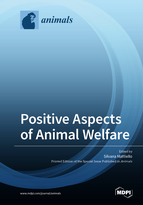Positive Aspects of Animal Welfare
A special issue of Animals (ISSN 2076-2615). This special issue belongs to the section "Animal Welfare".
Deadline for manuscript submissions: closed (30 September 2019) | Viewed by 74513
Special Issue Editor
Interests: animal welfare; animal behaviour; small ruminants; cattle; milk; wildlife conservation
Special Issue Information
Dear Colleagues,
During the last decades the interest in animal welfare has been greatly increasing among scientists, veterinarians, farmers, consumers, the general public and pet owners. As a consequence, several indicators have been developed and used under experimental conditions at the farm level or in the home environment to assess animal welfare and specific protocols have been proposed for welfare evaluation of various species in different contexts.
Most of the indicators developed so far focus on negative aspects of animal welfare (e.g. lameness, lesions, diseases, presence of abnormal behaviour, high levels of stress hormones, and many more), and only very few indicators are presently available to highlight positive aspects of animal welfare. However, the lack of negative welfare conditions represents just a minimum standard that should be guaranteed to animals, and it does not necessarily mean that animals are in good welfare conditions and have a good quality of life. To guarantee high welfare standards, animals should experience positive conditions, that allow them to live a life that is really worth living.
For these reasons, the new frontiers of animal welfare should aim to reach this high quality of life, and research should now focus on the development and validation of positive welfare indicators.
Original research papers addressing positive aspects of animal welfare, both in farm and companion animals, as well as in zoo animals, are welcome in this Special Issue. Topics of interest are the development and validation of new positive welfare indicators (behavioural, physiological, immunological, productive, etc.), the testing and refinement of existing indicators, the assessment of their reliability and feasibility, and the development of new welfare assessment protocols focusing on positive aspects. Additionally, special interest will be given to interdisciplinary approaches, such as the inclusion of neurosciences and recent technical advances in different disciplines that may open up new perspectives on positive welfare aspects.
Assoc. Prof. Silvana Mattiello
Guest Editor
Manuscript Submission Information
Manuscripts should be submitted online at www.mdpi.com by registering and logging in to this website. Once you are registered, click here to go to the submission form. Manuscripts can be submitted until the deadline. All submissions that pass pre-check are peer-reviewed. Accepted papers will be published continuously in the journal (as soon as accepted) and will be listed together on the special issue website. Research articles, review articles as well as short communications are invited. For planned papers, a title and short abstract (about 100 words) can be sent to the Editorial Office for announcement on this website.
Submitted manuscripts should not have been published previously, nor be under consideration for publication elsewhere (except conference proceedings papers). All manuscripts are thoroughly refereed through a single-blind peer-review process. A guide for authors and other relevant information for submission of manuscripts is available on the Instructions for Authors page. Animals is an international peer-reviewed open access semimonthly journal published by MDPI.
Please visit the Instructions for Authors page before submitting a manuscript. The Article Processing Charge (APC) for publication in this open access journal is 2400 CHF (Swiss Francs). Submitted papers should be well formatted and use good English. Authors may use MDPI's English editing service prior to publication or during author revisions.
Keywords
- Animal welfare
- Quality of life
- Positive emotions
- Behaviour
- Physiology
- Farm animals
- Companion animals
- Zoo animals
- Neurosciences
- Enrichments







